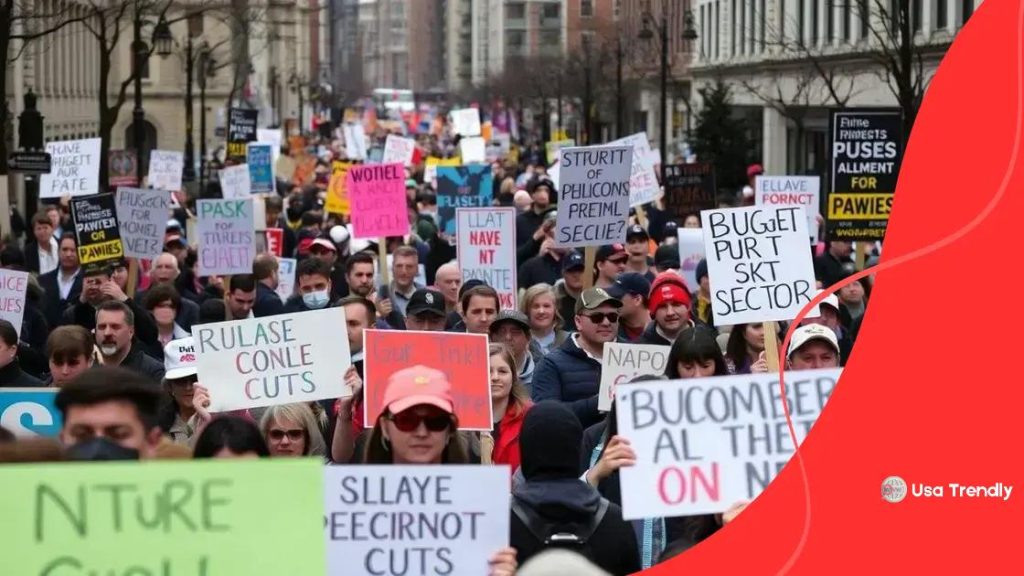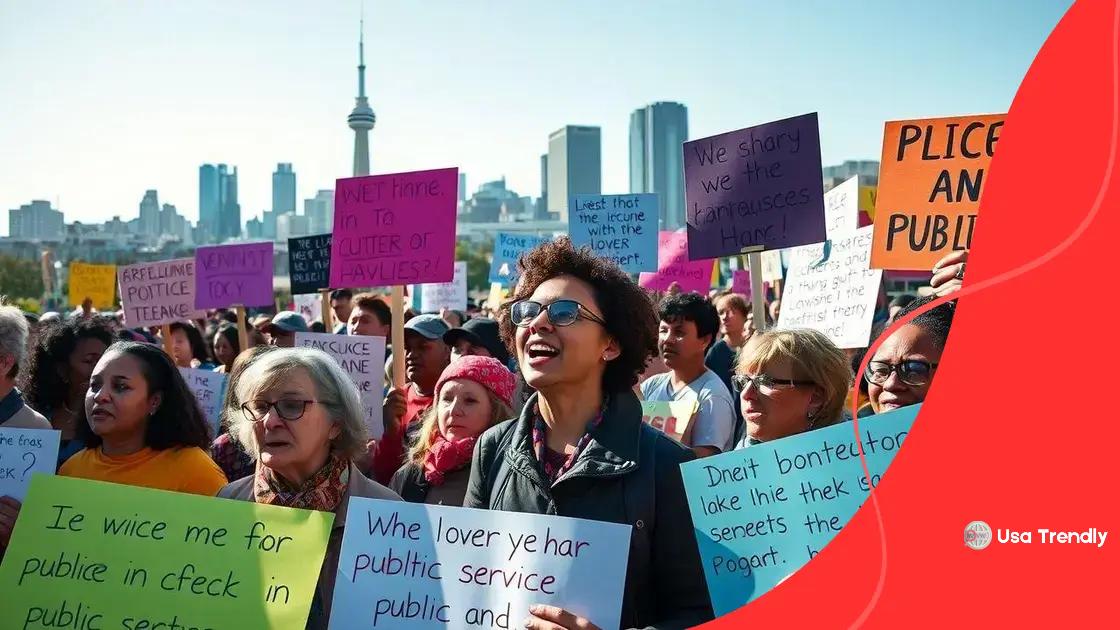Public sector protests intensify over budget cuts

Public sector protests intensify over budget cuts as communities demand better funding for essential services, highlighting the need for policy reforms and increased citizen engagement in decision-making processes.
Public sector protests intensify over budget cuts, highlighting widespread discontent among citizens facing reduced services. What does this mean for the future of public services? Let’s dive into the current situation and explore its implications.
Understanding the impact of budget cuts
Understanding the impact of budget cuts on public services is essential for grasping the current unrest. Citizens are feeling the effects firsthand, leading to increased frustration and protests.
Financial Strain on Essential Services
When budgets are cut, essential services like healthcare, education, and public safety tend to suffer the most. This can result in:
- Longer wait times for medical care.
- Decreased resources for schools.
- Limited emergency services availability.
Citizens often perceive reductions in these services as a direct threat to their quality of life. It raises urgent questions about the future of public service sectors.
Community Response to Budget Cuts
Communities are responding to these challenges through protests and advocacy. They seek to raise awareness and influence policymakers. Grassroots movements have sprung up, where:
- Citizens gather to voice their concerns.
- Petitions are circulated to demand action.
- Public forums allow for discussion and organization.
The combination of budget cuts and these community actions reflects a growing desire for change. Many believe that sufficient funding is crucial for the sustainability of vital services. As the situation develops, more citizens will likely join the movement, amplifying their voices against further cuts.
Public sector protests are not just about discontent; they symbolize a collective demand for better funding and accountability from government leaders.
Historical context of public sector funding
Understanding the historical context of public sector funding is key to grasping today’s financial battles. The evolution of how public services are funded has shaped our communities significantly.
Key Moments in Funding History
Throughout history, various events have influenced public sector funding, including:
- The establishment of the welfare state in the mid-20th century.
- Economic recessions that prompt budget cuts.
- Legislative changes that redefine funding strategies.
These milestones have contributed to the current landscape where public funding can be volatile. Understanding these events allows us to see patterns in funding behavior.
Impact of Economic Policies
Government policies greatly affect public sector funding. During prosperous economic times, funding tends to increase as governments have more resources available.
- Investment in public services like education and health expands.
- Funding for infrastructure projects often sees boosts.
- Economic downturns typically lead to funding reductions.
These cycles create instability, leading communities to advocate for more sustainable funding models. Awareness of these historical cycles can help inform future approaches to budgeting.
The struggles of past decades remind us of the importance of effective funding strategies. As citizens, we must understand how history plays a role in shaping the debate on public sector funding.
Voices from the front lines

The voices from the front lines of public sector protests tell powerful stories. These individuals are often the ones most affected by budget cuts and changes in public services.
Personal Experiences of Protesters
Many protesters share their frustrations and hopes through powerful testimonies. They express how funding cuts have impacted their lives, including:
- Reduced access to healthcare services.
- Overcrowded classrooms in public schools.
- Increased response times for emergency services.
Hearing their personal stories humanizes the statistics and highlights the stakes involved. Each voice reflects a larger struggle for rights and basic needs.
Community Leaders and Activism
Community leaders are often at the forefront of organizing protests. They rally individuals around a common cause, using their platforms to amplify demands for fair funding.
- These leaders create awareness through social media and public speaking.
- They collaborate with other organizations to build larger coalitions.
- Advocacy groups often share resources and strategies to support the cause.
The passion and dedication of these activists energize movements, while their efforts help to keep public attention focused on vital issues. The collective voices of these activists serve as a reminder of how important public services are to all citizens.
Engaging with these stories allows us to understand the urgent need for change, showing that every voice matters in the fight for more equitable funding.
Strategies for improving public service funding
Implementing effective strategies for improving public service funding is crucial for ensuring that essential services remain operational. Several approaches can be taken to stabilize and enhance funding sources.
Diversifying Funding Sources
One key strategy is to diversify funding sources. Relying on a single funding stream can be risky. By tapping into various resources, public services can achieve greater stability. Some potential sources include:
- Grants from federal and state governments.
- Private donations and philanthropic support.
- Public-private partnerships that foster shared investment.
These diversified funding sources can create a more resilient financial structure, allowing services to withstand economic fluctuations.
Advocacy and Community Engagement
Active community engagement is vital for advocating for better funding. When citizens voice their needs, they can influence policymakers. This can happen through:
- Building coalitions with local businesses and organizations.
- Encouraging public forums to discuss funding needs.
- Using social media campaigns to raise awareness.
Engaging with local communities helps to create a unified voice, putting pressure on decision-makers to prioritize public service funding.
Efficient Resource Management
Improving the efficiency of existing resources can also make a significant difference. Public services can optimize their budgets by
- Conducting regular audits to identify wasteful spending.
- Investing in technology to streamline processes.
- Training staff to improve service delivery while reducing cost.
Efficiency not only saves money but also demonstrates a commitment to responsible management, which can help attract further funding.
Strategically improving public service funding requires a comprehensive approach, focusing on diversification, advocacy, and efficient use of resources. Together, these strategies can help secure the necessary financial support to maintain vital public services for all citizens.
Possible outcomes of the protests
The possible outcomes of the protests over budget cuts in the public sector are significant and varied. As citizens rally for change, the impacts can shape policies and reform the system.
Policy Reforms
One potential outcome is policy reform. Governments may respond to protests by revisiting budget allocations and policy decisions. This could lead to:
- Increased funding for essential services.
- Implementation of more transparent budgeting processes.
- Greater stakeholder involvement in budget planning.
Such reforms can create a more equitable distribution of resources, addressing the needs of underserved communities.
Community Engagement
Increased community engagement is another likely outcome. Protests often bring attention to issues that might otherwise be overlooked, leading to:
- More citizens participating in local governance.
- Formation of advocacy groups to sustain the fight for funding.
- Increased dialogue between citizens and their representatives.
This enhanced engagement can help foster a culture of civic responsibility, where individuals feel empowered to voice their concerns regularly.
Public Awareness
Protests can also raise public awareness of key issues related to public sector funding. As people learn more about the implications of budget cuts, they may:
- Become more informed voters.
- Challenge misinformation about public spending.
- Support initiatives that prioritize public services.
The shift in awareness can play a vital role in the long-term sustainability of public services, as informed citizens advocate for necessary changes.
Ultimately, the outcomes of these protests can lead to a more responsive and accountable government that prioritizes the needs of its constituents. By shining a light on the challenges faced due to budget cuts, protesters not only seek immediate results but also pave the way for lasting change.
FAQ – Frequently Asked Questions about Public Sector Protests
What are the primary reasons for public sector protests?
Public sector protests often arise due to budget cuts that affect essential services like healthcare, education, and emergency services.
How can community engagement impact the outcome of protests?
Community engagement can strengthen protests by uniting citizens, raising awareness, and influencing policymakers to reconsider funding allocations.
What policies might result from these protests?
Protests can lead to policy changes that include increased funding for public services, improved transparency in budgeting, and more stakeholder involvement.
How can individuals get involved in advocating for better public service funding?
Individuals can participate by joining local organizations, attending public forums, and using social media to raise awareness about the importance of public services.
SEE MORE CONTENT